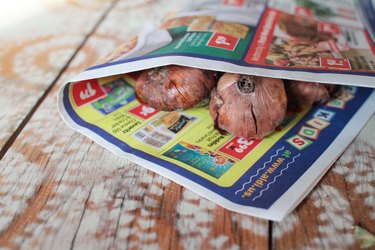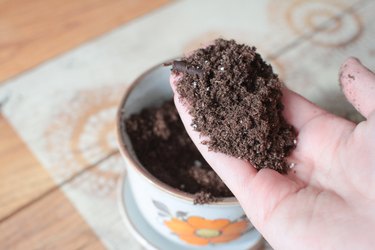
Bulbs are an easy way to create a perennial garden, and, once established, most bulbs require only minimal care. Depending on the species of flower bulb and your local climate, bulbs may be planted in the spring, summer or fall, and determining the best time to plant your bulbs will help ensure success for your garden.
Spring-Flowering Bulbs
Video of the Day

Daffodils, tulips, crocuses, irises, hyacinths and bluebells brighten up early spring days with their colorful blooms, sometimes even pushing up through the snow to flower. These bulbs require a period of cold in order to bloom, so they must be planted in the fall to flower the following spring. Plant spring-flowering bulbs approximately 6 weeks before the average first hard freeze date. This will give the bulbs some time to acclimate to their new surroundings and establish themselves before winter comes. Most spring-flowering bulbs are very low-maintenance, and in time will multiply and spread to create a lush flower bed.
Video of the Day
Summer- and Fall-Flowering Bulbs

Lilies, dahlias and gladiolas are some of the bulbs that flower in summer or fall, and these flowers do best if they are planted in the spring, as soon as the ground is workable. In cooler climates, some summer- and fall-flowering bulbs may not be winter-hardy and will need to be replanted every spring. Overwintering instructions will vary by species, but for most flowers, you will want to clip back all above-ground growth in the fall, after the blooms have faded but before any frosts, and allow the bulb to cure in the ground for a week or two. This will give the bulb some time to store food and prepare for winter. Dig up the bulbs before the ground freezes, and store in a cool, dry place, such as a basement or root cellar, loosely wrapped in newspaper or buried in sand or sawdust.
Basic Bulb Planting Tips

The soil should be soft and workable when planting bulbs, and most bulbs will benefit from an application of compost. (Some fertilizers can damage bulbs and roots.) Dig a hole that is two to three times deeper than the bulb is tall (i.e., a 2 inch tall bulb will require a 4 or 6 inch deep hole) and plant bulbs pointy end up. Water and light requirements will vary by species. Cover a freshly planted bulb bed with mulch, such as shredded leaves, to discourage squirrels and mice from digging up the bulbs. Bulbs are good candidates for mass plantings, and most can be planted very close together.